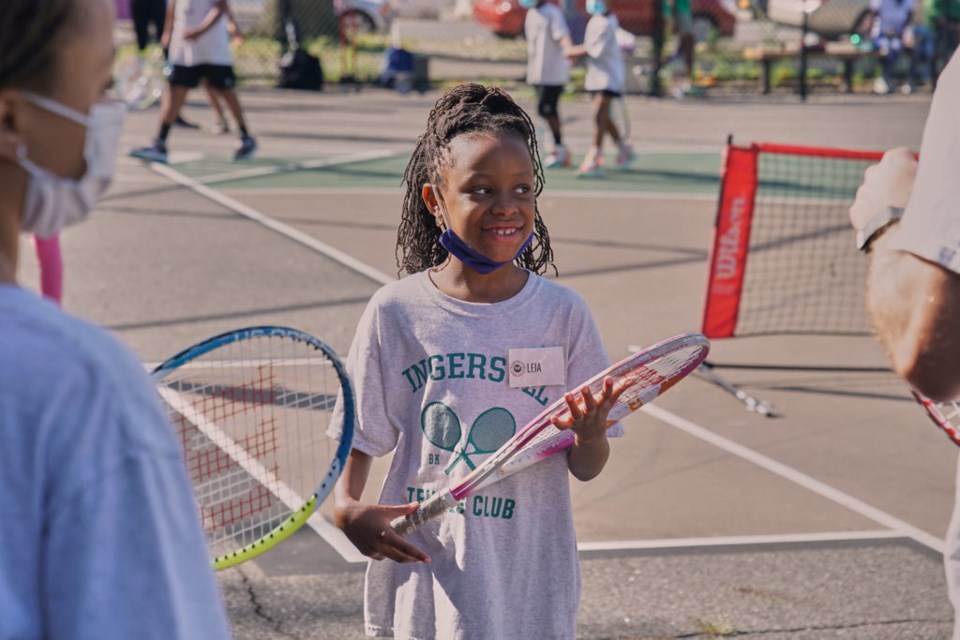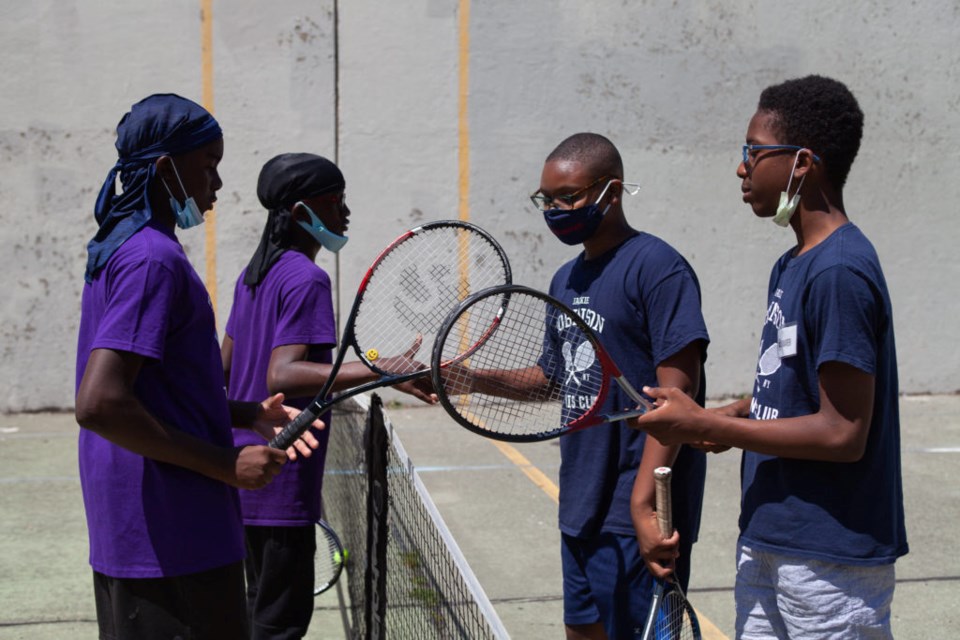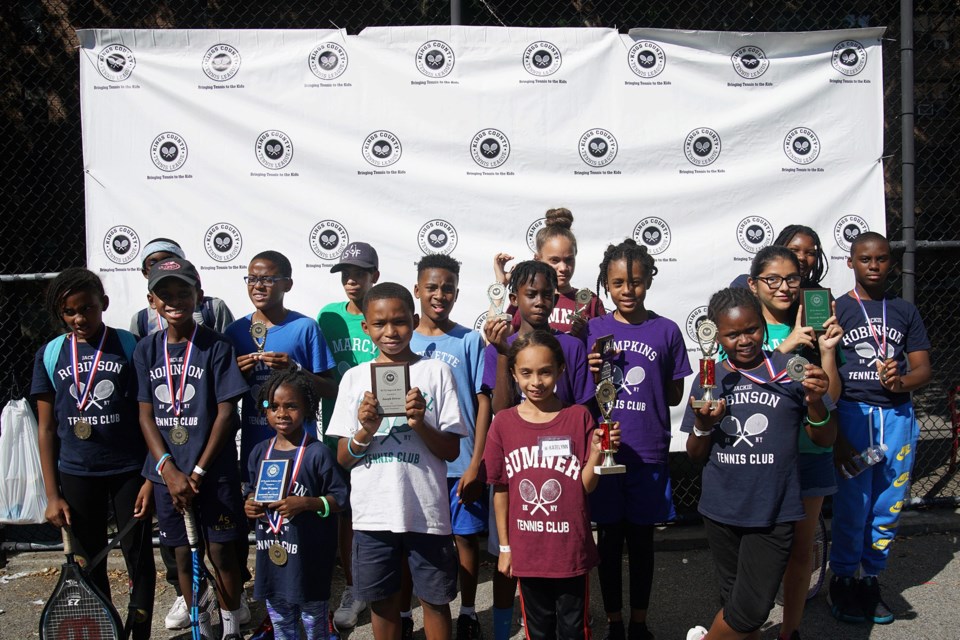Every Saturday morning, Jyranda Ross and her four-year-old daughter, Michaela, walk to Bed Stuy’s Tompkins Housing’s Courtyard to attend the Kings County Tennis League (KCTL), a free, competitive tennis program for children ages 5 to fifteen living in and around Brooklyn public housing.
After just four months of practice with KCTL, Ross has been told her daughter “swings like Serena.” With that much improvement in so little time, she asks: Can you imagine what she’ll be like in six or seven years?
Like Michaela, the more than 500 participants enrolled in the non-profit organization not only are learning how to dominate the court like Williams, but now are gaining access to college, paid jobs & workforce readiness with KCTL’s new programs to support older students as they prepare for their upcoming chapters.
And with the U.S. Open now in full swing, all these possibilities make a gold trophy seem not so far-fetched.
Tompkins Courtyard is one of the only New York City Housing Authority developments with a tennis court, right in the tenants’ backyard. It was renovated as recently as 2017, along with Sumner Housing, also located in Bed-Stuy, all thanks to KCTL.
Creating a distinct, usable space is one of the key components of KCTL, said KCTL Founder and Advisory Co-Chair Michael McCasland, as it is essential to have the children take pride in where they live and play.

“The idea is that the kids will have a safe, competent space to play tennis right out their door in public housing,” said McCasland. “Then, we bring the volunteers, the trained staff, and curriculum to them. We don’t want to just be a mass non-profit that puts rackets in kids’ hands and just calls it a day. We want to make sure we’re targeting kids in public housing.”
Over ten years ago, McCasland moved from North Carolina to Brooklyn to take a job as a forensic scientist. While walking through his new neighborhood he saw an unused (and rather unkempt) tennis court in Marcy Playground and felt that his years of competitive tennis would allow him to give back by bringing his knowledge of this skill to his new community.
It wasn’t until much later McCasland began to imagine that simply offering free tennis lessons could potentially lead to something bigger: a multi-dimensional organization.
“Once people started volunteering, I realized they were coming from all these diverse professional backgrounds, and from that you realize these kids are getting great value by hanging out with people from all these different industries and life experiences and so that’s when I said this should be a non-profit,” said McCasland.
“We get out here and bring tennis to where they live and use tennis as a vehicle for imparting life skills and social and emotional learning by meeting them where they are.”

As KCTL began to expand, soon the very impetus of the org, Marcy Playground, was fully renovated in 2014, along with the aforementioned Tompkins and Sumner courts. In addition, KCTL broadened their scope with other programs such as GoGirlGo!, an all female program where students and instructors not only practice tennis, but come together and chat, providing personal mentorship for female athletes, specifically.
The KCTL Pee Wee program partners with The Brooklyn Kindergarten Society (BKS) to teach tennis to children under four. Now, with the up-and-coming college and job programs, the children of KTCL are not only provided tennis lessons as a catalyst for life-long emotional and physical development, but for potential careers, as well.
“We really want to serve those populations and set them up for life,” said McCasland. “So in terms of the future, we want to deepen the impact and get them ready for college or for jobs and be responsible citizens, and we are getting closer to perfecting the delivery and also expanding out to other developments"
About two-thirds of the kids they teach come from households earning less than $48,000 per year. So while tennis can often be seen as elitist and inaccessible, the growing rate of demographic youth participants in tennis — thanks to orgs such as KCTL — is slowly breaking down this barrier.

And KCTL isn’t just providing access to tennis — they’re fostering community, as well. Jyranda Ross, whose four-year-old is next in line to take the gold once Serena Williams retires, just moved to Crown Heights a few months ago and already seen a difference in comfortability within her neighborhood not only through her children, but also herself.
“This is an excellent program for all the children, and parents, you have kids that come from outside the neighborhood and participate and that’s just another opportunity to make more friends,” said Ross. “So now my son is telling me, ‘Now I see some of the kids in my school going to play tennis.’ And that’s a great thing.”
This is true as well for eight-year-old Diamond Johnson, who has already made “best friends” after only being in the league for four months.
“I saw something going on on Saturday and asked my mom if she could sign me up,” said Johnson. “I didn’t know how to play until I joined, and then I practiced forehand, backhand and volley at home and here. The instructors are excellent and so good and I made so many friends.”
At its core, the KCTL model is replicable. The program hopes to one day have enough resources to reach every housing development in Brooklyn. Essentially, it is “localizing tennis.”
Although not a sport that inherently lends itself to ubiquitous access and opportunity, the Kings County Tennis League is making sure that its children think otherwise.




